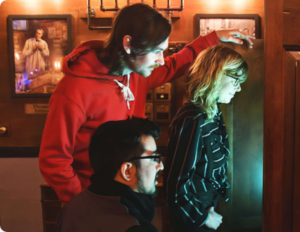Why Escape Rooms Are the Ultimate Story-Driven Activity
Beyond Trust Falls: The New Era of Team Building is Story-Driven
Corporate teams are evolving. The demand for team-building activities that are genuinely engaging, memorable, and effective has moved far beyond traditional happy hours or trust falls. Today’s forward-thinking companies seek experiences that do more than just gather employees in a room; they want to forge stronger bonds through shared challenges and triumphs. This has given rise to a new category of corporate events: story-driven activities.
A story-driven activity is an event where a compelling narrative provides the context and motivation for a team’s actions. Instead of completing disconnected tasks, the group works toward a unified goal that is deeply integrated into a story. This narrative framework transforms a simple group outing into a shared adventure. While many activities now market themselves as story-driven, high-production immersive escape rooms offer an unparalleled level of engagement, collaboration, and cinematic storytelling that sets a new standard for what a team-building event can be.
What Defines a Truly ‘Story-Driven’ Experience?
A great narrative activity is built on more than just a theme. To be truly story-driven, an experience must meet several key criteria. First, it requires an immersive environment that transports the team out of their everyday world and into the story. Second, it demands active participation, where the team’s choices and actions directly influence the outcome. This concept, often called player agency, is what separates a passive audience from an active protagonist in the unfolding narrative [1].
Furthermore, the team’s goal must be intrinsically tied to the story’s progression. The challenges they face should not be arbitrary puzzles but meaningful obstacles that make sense within the world of the narrative. Finally, the experience must be built around meaningful collaborative challenges. The story should necessitate teamwork, pushing participants to communicate, share information, and solve problems together. When the narrative itself is the engine for collaboration, the team-building benefits feel natural and profound [2].
Comparing Narrative Activities: Which Tells the Best Team Story?
Corporate event planners have several options when seeking a narrative-based activity. While each has its merits, they differ significantly in their ability to deliver a truly immersive and collaborative story.
Murder Mystery Dinners
Murder mystery parties are a classic form of narrative entertainment. They provide characters, a plot, and a clear objective. However, these events often rely on scripts and predetermined roles, guiding participants through a story rather than letting them drive it. According to guides on hosting these events, the structure is often focused on character interaction and information exchange rather than environmental problem-solving. The experience can be more about acting out a part than collectively overcoming a dynamic challenge.
Corporate Scavenger Hunts
Scavenger hunts get teams moving and working together to find clues. They encourage exploration and can be an energetic way to see a location. The weakness often lies in the narrative itself. The ‘story’ is frequently a thin thematic layer applied over a series of disconnected tasks. The hunt may lack a central, immersive world, making the narrative feel secondary to the checklist of objectives.
Tabletop Role-Playing Games (TRPGs)
Games like Dungeons & Dragons offer perhaps the deepest narrative experience, with boundless creativity and collaborative storytelling. Research highlights their effectiveness in developing leadership and creative problem-solving skills. However, their reliance on pure imagination can be a barrier for corporate teams. Without a physical environment to ground the experience, TRPGs can be intimidating for newcomers and may not provide the same tangible, multi-sensory engagement as other activities.
The Escape Room Advantage: Where Your Team Becomes the Hero
Immersive escape rooms uniquely combine the best elements of other narrative activities into one cohesive and powerful package. They offer the narrative depth of a mystery, the active problem-solving of a scavenger hunt, and the collaborative roles of a role-playing game. The crucial difference is that in an escape room, the team is not just an audience to the story—they are the protagonists. Their actions, discoveries, and solutions directly drive the narrative forward.
This is achieved through a tangible, multi-sensory environment that creates a ‘cinematic experience.’ The story is told not just through text or a game master, but through the set design, the props, the soundscape, and the puzzles themselves. Every lock, code, and hidden passage is a piece of the story waiting to be uncovered. This structure inherently fosters communication and teamwork, as success is impossible without the group working as a single, cohesive unit [3]. The shared goal and the pressure of the clock create a powerful bonding experience that translates directly into improved workplace dynamics.
Case Study: Unrivaled Storytelling at Palace Games
At Palace Games, our experiences are designed from the ground up to be premier story-driven adventures. Located within San Francisco’s historic Palace of Fine Arts, our award-winning rooms are deeply integrated with the history and grandeur of our unique venue, creating a level of immersion that is simply unrivaled.
In The Roosevelt Escape Room, your team is not just solving puzzles; you are presidential advisors in a tense, pre-WWI setting, tasked with decoding secrets to avert a national crisis. The story unfolds through historical artifacts and intricate mechanisms, placing your team at the center of a historical turning point.
The Edison Escape Room challenges your team to uncover the final secret of the world’s greatest inventor. The narrative is one of discovery and legacy, as you explore a hidden laboratory filled with his forgotten work. The puzzles are extensions of Edison’s own ingenuity, making the problem-solving process feel like a genuine journey into his mind.
For a story built on suspense and spectacle, The Great Houdini Escape Room pits your team against the master illusionist himself. You must work together to uncover the secrets of his magic and outsmart him in a high-stakes challenge. The narrative tension is palpable, making every success feel like a hard-won victory.
Conclusion: Choose a Shared Adventure, Not Just an Activity
For team building to create a lasting impact, it must be more than just an activity; it must be a memorable, shared adventure. While other events offer narrative elements, the unique combination of physical immersion, integrated puzzle-solving, and high-stakes storytelling makes premium escape rooms the ultimate choice for a story-driven experience.
By placing your team at the heart of the story, you give them a chance to become heroes in their own right. They will communicate, collaborate, and problem-solve in ways that a simple dinner or workshop cannot replicate. When planning your next corporate outing, consider giving your team a story they will tell for years to come. Explore our unforgettable team experiences to find the perfect adventure for your group.



